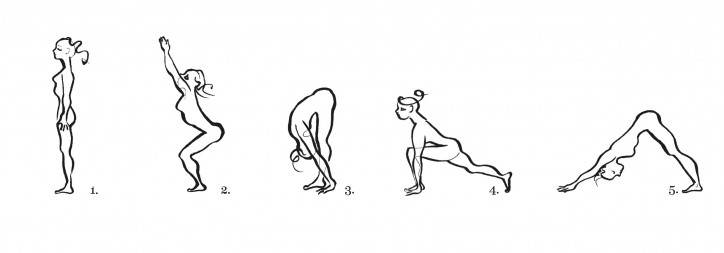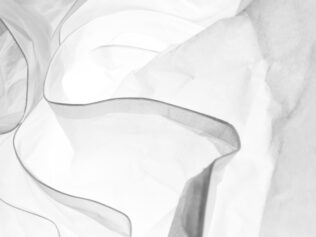
A Sun Salutation for the Stiff, the Unskilled, and the Skeptical
This set of exercises comes recommended by yoga practitioners as an easy way to wake up, while stretching the muscles. They can be done while still drowsy, staying in each position for thirty seconds or so, otherwise more energetically, changing positions in rhythm with the breath. You can also combine the two methods. At any rate, let’s begin with the dynamic version.

1. Stand up straight with feet shoulder-width apart, arms by your side, breathe deeply.
2. Inhale, bending your knees and raising your arms. Your back should be straight, pulling in your abdomen, stabilizing your spine. Bend your knees until you feel your calves stretch. The heels should be planted on the floor.
3. Exhale and lean forward. Bend your knees so as to rest the palms of your hands on the floor. As your body becomes more flexible, you can straighten your legs.
4. Now inhale and reach your right leg far back—right foot supported by the toes, knee straight. Straighten your back; your left leg should be bent at a ninety-degree angle.
5. Exhale, place your left foot parallel to the right, push your buttocks up and back. Keep your arms, legs, and spine straight.
6. Inhale—reach your right leg forward to Position 4.
7. Exhale—bring your left leg forward to Position 3.
8. Inhale—bend your knees and rise to Position 2.
9. Exhale—return to Position 1.
Smile.
Human Photosynthesis
The good news is that during the warmer seasons, there’s enough sun for the human body to produce all the vitamin D it needs. All that’s required is to spend fifteen to twenty minutes a day in the sunlight, with exposed arms and legs, and no sunscreen. That’s about how long it takes to read four pages of Przekrój.
“The energy needed for vitamin D production comes from the sun’s rays, though not those in the visible range, but the shorter and imperceptible wavelengths of ultraviolet (UV) radiation. Thus, it is the animal equivalent of photosynthesis in plants, though obviously the final products in both cases are different,” writes Marcin Ryszkiewicz in his book Homo sapiens. Meandry ewolucji [Homo Sapiens: The Meanderings of Evolution]. Vitamin D is needed for both normal bone development and maintenance, as well as proper immune system function.
Laughing Through Tears Makes Rainbows More Likely
In the early-11th century, Ibn al-Haytham, author of the Book of Optics, concluded that rainbows are
created by sunlight interacting with water before reaching the eye.
*
A rainbow can appear anywhere on Earth, at any time of day and year. You never know.
*
The band colored red in a rainbow always appears at the top, closer to the sky, and the blue at the bottom, toward the ground.
*
Each of the rainbow’s arcs draw the same angle between the rays of the sun and the eye of the observer—between forty to forty-two degrees—at least on Earth. On one of Saturn’s moons, called Titan, light is refracted not in drops of water but in liquid methane at an angle of forty-nine degrees, which means that—if they exist—rainbows there would be bigger.
*
Both a universal and individual phenomenon, the observer is always at the center of a rainbow’s arc. It is unknown who would observe one on Titan, if anyone.
*
There are no herbs that can’t be cultivated on a sunny windowsill.
*
The ideal companion for the perennial lovage plant is parsley. For that, cilantro is not to be planted with dill—they’ll like each other too much and might cross-pollinate.
*
Oregano, mint, and sage tend to grow so rampantly that it’s better to plant them away from basil, marjoram, and rosemary, so as to give them a fighting chance.
*
Savory and marjoram love sunlight, while thyme really needs a lot of it to survive. It should bloom pink in May, but this rarely happens on a windowsill.
*
On the plate, thyme is good with potatoes and legumes. And as a result, it’s also good for digestive and respiratory systems.
*
When sunburned (while tending to herbs on the balcony, for example), it’s worth applying essential oils of lavender, aloe, or chamomile.
*
Every minute you laugh adds an hour to your life (Chinese proverb).
*
Stand facing someone, look into each other’s eyes and repeat: “Ha, ha ha. Ho, ho, ho. Hee, hee, hee.” Apparently, there’s a chance you’ll soon be laughing from the depths of your belly. This is not a joke, but a laughter yoga exercise, invented in the mid-90s.
*
Laughter prompts our bodies to excrete endorphins, known as the “happiness hormones.” They reduce pain and promote relaxation.
*
When we laugh, we breathe more deeply. Our brain receives more oxygen, blood flows faster, and more ideas flood the mind.
*
In the Indian city of Bangalore, Karnataka, is Laughter Yoga University. Apparently the point is to learn to laugh for no reason.
*
An hour of intense laughter can burn a hundred calories. But what could be so amusing for sixty-minutes straight?
*
The field of research on laughter and its effects on the body is called gelotology. Seriously.
*
Just reading the word “laugh” improves mood. It appears in this piece twelve times.









